What is Demurrage and Detention in Shipping?
What are Demurrage Charges?
When importing goods, demurrage is the cost to the consignee for the delay in picking up such goods from the port after unloading them from the vessel.
The demurrage fees vary from carrier to carrier, between ports, and the type of equipment used, i.e., dry container, refrigerated container, etc.
In export, instances of a container being delivered to the ocean carrier but remaining in port for an extended period for various reasons cannot be ruled out. These containers may even miss the sailing.
In such cases also, demurrage may apply. Demurrage charges are fixed per container per day.
Demurrage is the recovery of costs incurred for delay of the container within the port, charged by the shipping company or the party that has leased the container.
Container leasing is a booming 5.5 billion Dollar industry that leases cargo containers to their customers and manages a fleet of containers for them.

What are Diem charges/Detention Charges?
Once a container discharged from the vessel is taken from the port to the customer’s premises and offloaded, the empty container (also called empties) has to be returned to the port from where it has been picked up or to the empty container depot.
If the consignee (customer) or shipper delays returning the empty container as agreed, the carrier will start charging the consignee after a certain number of days. These are called detention charges or detention fees. Like demurrage, it is also charged per container per day.
When an empty container is taken to the consignee’s yard for stuffing (loading of cargo for export), the loading must be completed on time, and the container must be returned to port.
Besides missing the sailing, inordinate delays will result in detention charges being applied by the ocean carrier.
Ports and ocean carriers have various price mechanisms that are put in place for their successful daily operations and to cover their costs.
Demurrage can also be viewed as a price mechanism to prevent congestion at ports by encouraging customers to move their containers within a specified time limit.
Detention, on the other hand, deters customers from keeping equipment with them for periods longer than the prescribed limit.
Delays in returning empty containers prevent the equipment owner from leasing it out to other customers.
Demurrage and Detention Charges Free Days
Demurrage and detention charges are different between ports and carriers. Generally, extra free days are allowed as follows:
For a 20 or 40 feet dry container, demurrage usually kicks in from day 6. In other words, the free period or free time during which it can remain inside the port after discharge is five days.
The more days a container remains in port, the more demurrage has to be paid to the carrier. 6-10 days will be charged at a rate per day/per container, 11-15 days at a higher rate, and from day 16 onward, it is usually the maximum rate per day/container.
Demurrage charges for refrigerated or reefer containers are more than for dry containers. The first three days are free. With the maximum rate, the rates go up in slabs from 4-8 days, 9-13 days, and 14 days onward.
Detention charges also start mostly after the free days, as in demurrage.
Demurrage and detention charges, if not planned and handled correctly, can add up to the cost of clearing goods for the consignee.
Combined Demurrage and Detention or Merged D&D
Another standard method of charging the customer for not picking up the discharged cargo or returning the destuffed containers on time is through the combined demurrage and detention charges.
Also referred to as merged D&D, it gives a flat number of days to clear the container after discharge from the vessel and return the empty container to the port or container depot, as agreed. In this case, demurrage and detention charges are not calculated separately.
For example, if the consignee gets 12 days of merged D&D, he has to clear the goods, take them to his warehouse, offload the cargo, and return the empty to the carrier within 12 days.
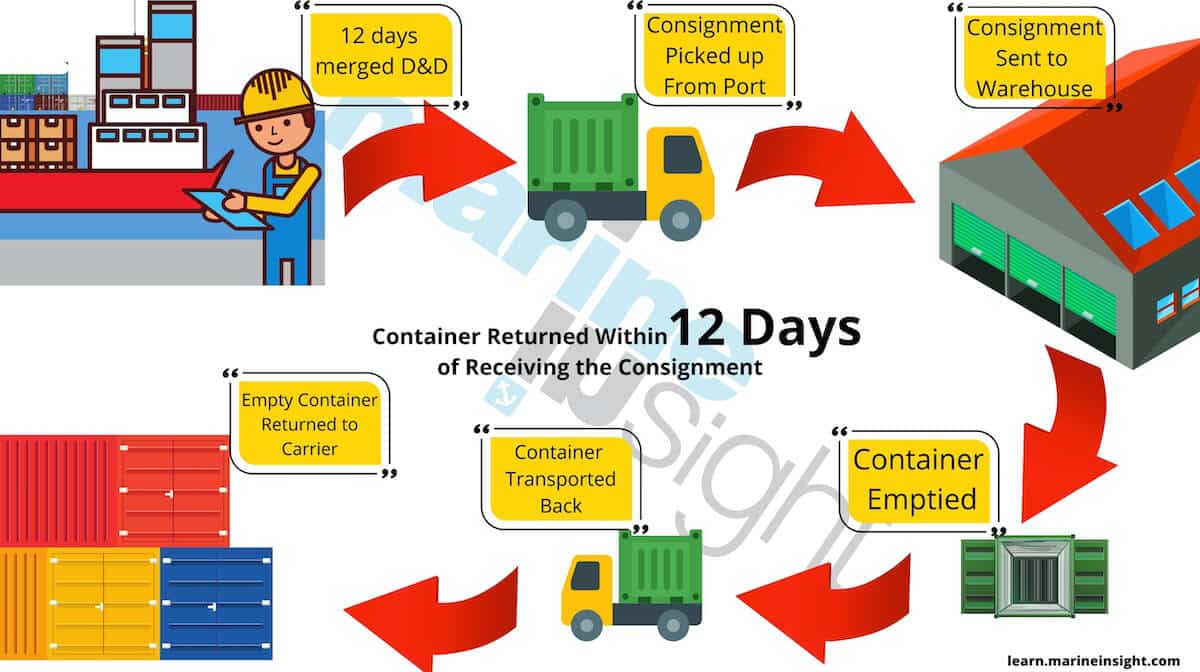
Do Demurrage and Detention Apply to Less-than-Container Loads (LCL)?
An LCL shipment usually comes as a consolidation with other cargo belonging to other customers. Since the entire container is not used by a single customer, demurrage or detention does not apply to the FCL (Full Container Load).
However, the carrier may charge the customer for the space occupied by his cargo in the container freight station (CFS) beyond a certain number of days without clearing.
A CFS is a yard or warehouse within the port where such LCL cargo is consolidated (before export from various consignors) with other export cargo or deconsolidated (after the discharge of the container from the vessel) for distribution to multiple consignees.
Cargo consolidators or groupage operators have their own or leased warehouses, and with an efficient clearance team, they can avoid such charges.
Time Study and Turnaround Time
How do time study and turnaround time relate to ocean vessels, containers, and trucks transporting cargo?
What is time study and turnaround time, and how does it help to control demurrage and detention charges?
Time study is the observation of the different components of a job process, recording of the time taken by each, and the detailed analysis of each of these components.
Turnaround time is the commonly used term for the time taken between the arrival and departure of equipment. In its simplest meaning, it is the time taken to complete a task.
When an organization has abnormally high demurrage and detention charges, time study and analysis of turnaround time helps to understand the reasons behind delays in taking delivery of container loads and returning the empties.
The Average Turnaround Time or ATT of a process is a valuable measure in the hands of a logistician who can plan or look at ways of reducing it and thereby prevent or reduce charges incurred due to delays. Increased turnaround time can result in increased demurrage and detention charges.
For a truck, turnaround time is the time from gate-in (the time recorded when the truck enters the port terminal or warehouse) to gate-out (the time shown when the truck exits the port terminal or warehouse).
This time would therefore include the time taken for loading or unloading cargo, customs inspection, and cargo documentation. Ensure that your truckers pickup the cargo at the right time. For an ocean vessel, this is the time between its entry into the port and departure.
This time includes discharge or intake of cargo, customs inspection and documentation, bunkering, and routine ship maintenance if any.
For the container load, it is the time taken when it exits the port and when it is returned to the port or container depot after destuffing.
The ocean carrier decides whether the container has to be returned to the port or the designated container depot and informs the customer in advance.
In all these cases, a shorter turnaround time is always desirable. A shorter turnaround time means lesser costs associated with storage, be it the cargo or the empty equipment.
In a busy environment, a high turnaround time from one party can cause a chain reaction leading to congestion at the port or warehouse or even traffic build-up. Delays invariably lead to demurrage or detention charges to the customer.
Key Performance Indicators and Root Cause Analysis
Charges incurred because of demurrage and detention eat into an organization’s overall profit.
Key Performance Indicators (KPI) and Root Cause Analysis (RCA) are useful tools to monitor and control such charges.
KPIs are measures that indicate the performance of various activities within an organization. These are measurable values used to compare past and present performance.
Root Cause Analysis (RCA) is another tool that helps to find out the key reasons causing specific problems within an organization and ways to avoid them.
While KPI helps to compare and understand trends, the RCA helps to understand the cause of problems and ways to remedy them.
KPI related to demurrage and detention charges help to understand the trend of these within an organization or department. Negative trends can be arrested incredibly through studying its RCA and taking preventive measures.
Can demurrage and detention charges be reduced or avoided?
The answer is yes. Proper planning of equipment, labour, transport and administrative functions dramatically reduces or even avoids these charges.
Demurrage and detention charges are avoidable though they may be unavoidable in certain circumstances. Container turnaround time is critical if businesses are to avoid or reduce these charges.
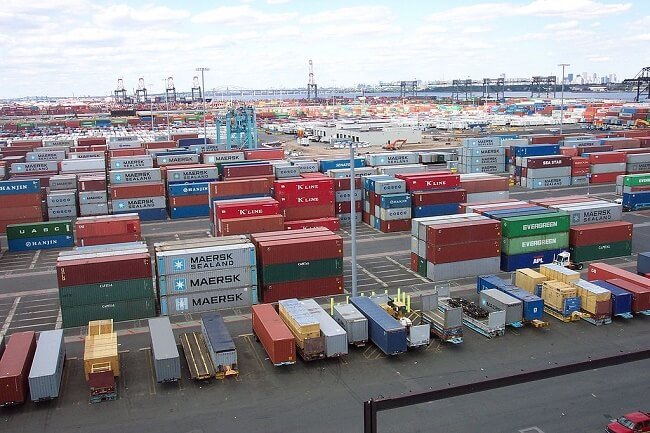
Customs clearance, for example, may take time, and delays can result in the customer having to pay demurrage. Companies can plan by factoring in the time taken on account of clearance delays.
Planning is equally important in avoiding detention charges. Ensure that storage space to receive the cargo, labour, and equipment are ready before the container reaches the consignee’s warehouse or yard.
An effective communication network with contacts at the port, clearing agents, etc., is also crucial.
Though unfamiliar, consignees can negotiate demurrage with the ocean carrier.
Depending on the regularity and volume of the business involved, the ocean carrier may allow the customer more free days for the cargo at the port.
Global Demurrage and Detention Charges
As far as demurrage and detention charges are concerned, the US ports are reportedly the most expensive. Demurrage rates in the US ports vary between USD 165 – USD 275 for a 20 feet container (TEU). European ports charge much less, followed by ports in the Middle East, Asia, and China.
Demurrage and detention charges are not the only charges the consignee incurs on the container. When the port storage area or the container yard (CY) is used for storing goods temporarily, there is a charge associated with that from the port. This is known as the port storage charge. Storage charge is calculated from when the goods enter the storage area until it exits.
Port dues cover the operational and maintenance costs of ports. These costs are passed on to ocean carriers and even boats that use the port facilities. Though ports charge several fees to their users, the main fees are tonnage, cargo, and port dues.
Tonnage dues are charged on the weight of the carrier or vessel. Each ship must carry a tonnage certificate issued by the relevant authority. This certificate shows the gross and net tonnage of the vessel by the ICTM or International Convention of Tonnage for Measurement of Ships (1969).
The International Convention of Tonnage for Measurement of Ships (1969) was concluded in London in 1969. The convention was held under the patronage of the International Maritime Organization (IMO). The participating countries decided to establish rules and principles, especially concerning the tonnage of ships used in international voyages.
These rules and principles could be applied uniformly by all the participating countries to avoid different regulations and interpretations in other countries.
Cargo dues or wharfage is the charge for using the port facilities and moving cargo through them.
Port dues are also based on the vessel’s tonnage and the time it spends in the port.
When the logistics of cargo movement are not planned properly, it can result in increased charges both from the port and the carrier, such as demurrage or detention.
Costing of Goods
The charges mentioned above are passed on to the customer by the ocean carrier; hence, they can be factored into the organization’s costing methodology.
Though the tonnage charges depend on the weight of each vessel, most of the charges are published annually by the port or relevant authorities; therefore, they can be easily included in budgeting and costing.
When demurrage and detention charges are incurred regularly by a business, these costs also have to be factored into the budget.
At the same time, every effort should be taken by the concerned department within the business to gradually reduce and perhaps avoid demurrage and detention on imported or exported goods. This can be done in many ways by preparing for port congestion, labour shortages or bad weather.
Frequently Asked Questions
1. What are demurrage charges?
When importing goods, demurrage is the cost to the consignee for the delay in the pickup of such goods from the port after unloading them from the vessel.
2. What are detention charges?
If the consignee (customer) or shipper delays returning the empty container, the carrier will start charging the consignee after a certain number of days. These are called detention charges or detention fees. Like demurrage, it is also charged per container per day.
3. What do you mean by combined demurrage and detention charges?
Also known as the merged D&D, it gives a flat number of days to clear the container after discharge from the vessel and return the empty container to the port or container depot, as agreed. In this case, demurrage and detention charges are not calculated separately.
4. What do you understand by time study?
Time study is the observation of the different components of a job process, recording of the time taken by each, and the detailed analysis of each of these components.
5. What do you mean by turnaround time?
Turnaround time is the commonly used term for the time taken between the arrival and departure of equipment. In its simplest meaning, it is the time taken to complete a task.
You might also like to read:
- Bill Of Lading in Shipping: Importance, Purpose, And Types
- What is Seaway Bill in Shipping?
- What is Merchant Haulage?
- What Is CBM Rate In Shipping?
- Telex Release: Everything You Wanted to Know
Disclaimer: The authors’ views expressed in this article do not necessarily reflect the views of Marine Insight. Data and charts, if used, in the article have been sourced from available information and have not been authenticated by any statutory authority. The author and Marine Insight do not claim it to be accurate nor accept any responsibility for the same. The views constitute only the opinions and do not constitute any guidelines or recommendation on any course of action to be followed by the reader.
The article or images cannot be reproduced, copied, shared or used in any form without the permission of the author and Marine Insight.
Do you have info to share with us ? Suggest a correction

About Author
Hari Menon is a Freelance writer with close to 20 years of professional experience in Logistics, Warehousing, Supply chain, and Contracts administration. An avid fitness freak, and bibliophile, he loves travelling too.
Latest Maritime law Articles You Would Like:
Latest News
- What is the Purpose of DG Shipping?
- What are Logistics Risks?
- How Port and Terminal Operators Can Control Emissions?
- Minimum Quantity Commitment (MQC) and Liquidated Damages in Container Shipping: Concept and Relevance
- MARPOL (The International Convention for Prevention of Marine Pollution For Ships): The Ultimate Guide
- The Ultimate Shipping Container Dimensions Guide
Subscribe To Our Newsletters
By subscribing, you agree to our Privacy Policy and may receive occasional deal communications; you can unsubscribe anytime.




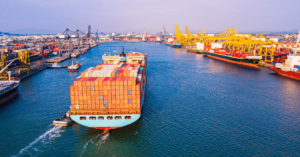
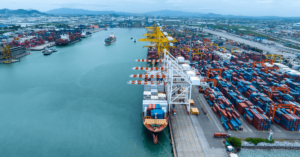
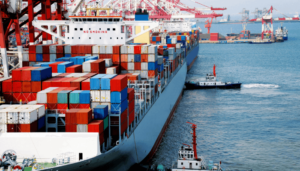

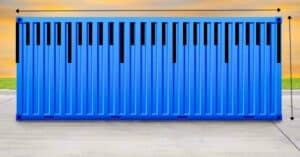



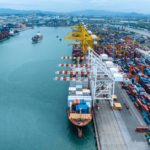



An LCL shipment usually comes as consolidation with other cargo belonging to other customers. Since the full container is not used by a single customer, demurrage or detention does not apply on the FCL (Full Container Load).
for above sentence, demurrage and detention does not apply on the FCL? Is it a typo?